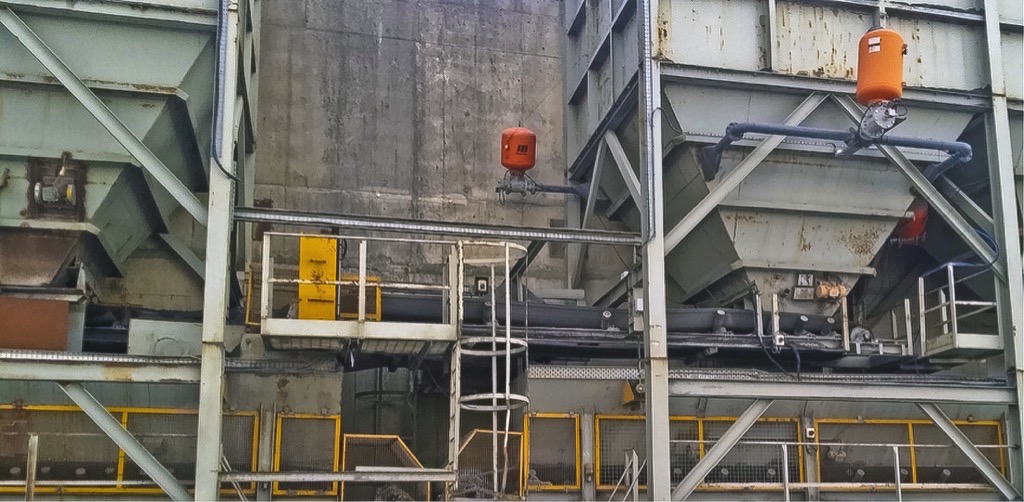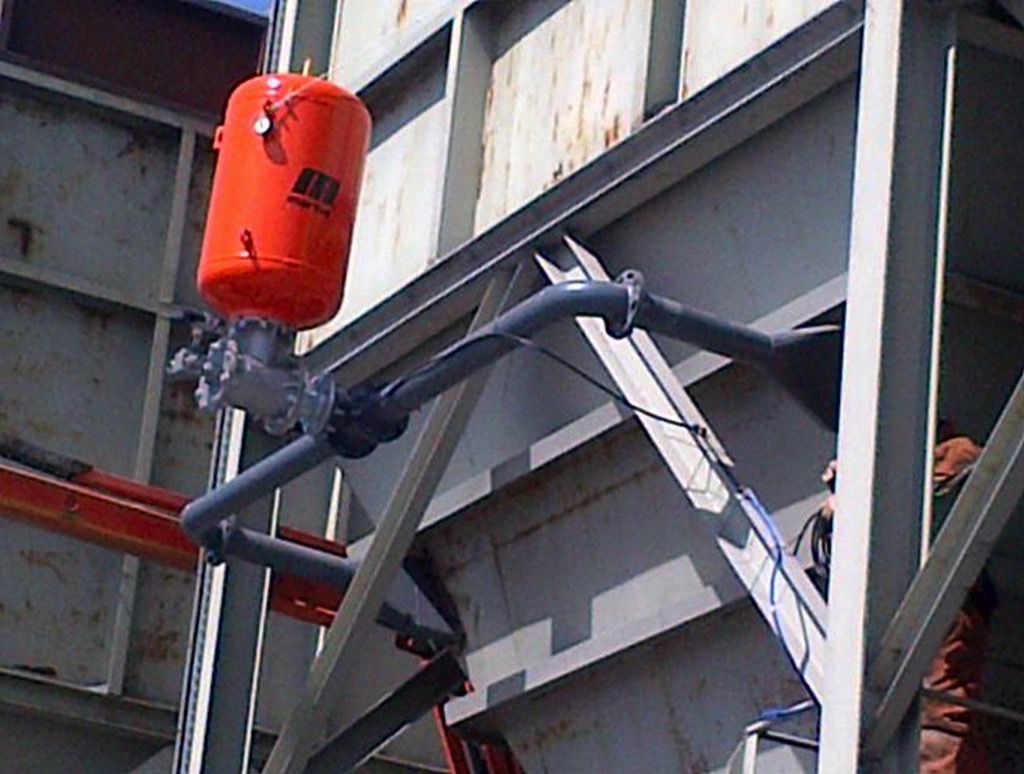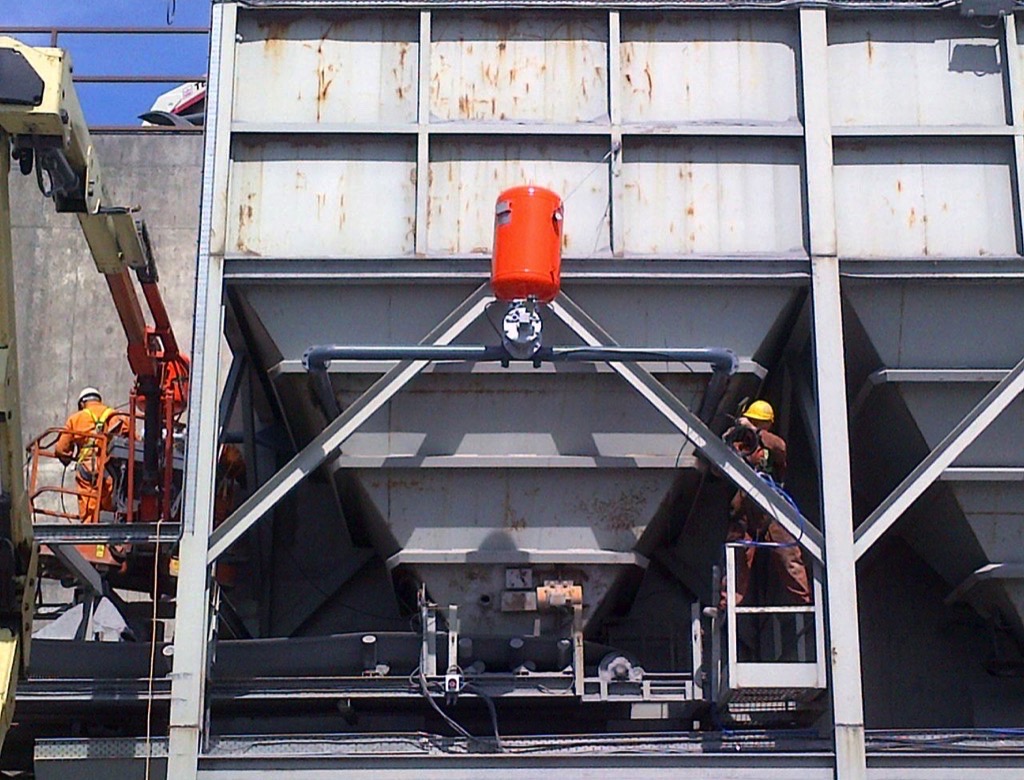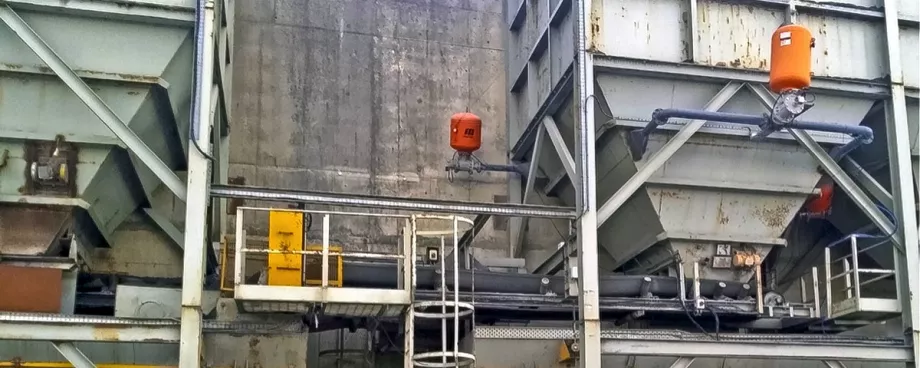(From the archive of ”bulk solids handling", article published in Vol. 35 (2015) No. 4 , ©2015 bulk-online.com)

Although technology for industrial concrete production has made great strides, the hopper’s basic funnel design still tends to accumulate build-up in cement manufacturing operations, which can eventually lead to clogging and process downtime. That was the problem CRH Roadstone Limited, a cement and concrete block production firm located in Waterford, Ireland, was experiencing. The company found that the limestone dust extracted from the quarry, once screened and loaded into the dust bin, built up until it left just a center hole for discharge, seriously affecting production.Regular clearing of obstructions required the time-consuming use of a mechanical digger, which scooped material out of the open mouth of the hopper from the loading area located above it. Fed up with the downtime and maintenance costs, CRH Roadstone contacted a local engineering firm, Plimley Trading Limited of Newbridge, Ireland, which specializes in metal fabrication and customized engineering solutions for concrete manufacturers. As a distributor of Martin Engineering products, Plimley also invited the flow products manufacturer into the process to help devise a cost effective solution.“We [Plimley together with Martin Engineering] carried out a material flow project for the same customer at a different location in 2012 and it was a complete success,” explained Shane Dunne, Senior Engineer for Plimley. “Based on that, the manager asked us to have a look at the hopper in question with a view to resolving the material build-up problem.”
The Hopper and the Rathole
CRH Roadstone is one of the oldest producers of cement and concrete products in Ireland. It is part of Cement-Roadstone Holdings (CRH), the largest building materials provider in North America and a regional leader in Europe, with an emerging presence in major Asian economies. The Waterford, Ireland quarry location is a core facility for the company’s regional production. At the Waterford facility, front loaders transport screened limestone dust and sand from the quarry to the tiered loading area secured by a tall retaining wall. Next to the wall, the 24 foot high (7.31 m) split pyramid hopper is comprised of two square bins with inverted pyramid-shaped discharge points at the bottom, which unload onto separate conveyors leading to either the concrete block production facility or the cement processing plant.With shallow base slopes and sharp corners, the bins in the pyramid hopper have a tendency to accumulate damp material. After the front loader was done dumping and discharge would stop flowing onto the conveyors, operators assumed the bin was empty, but material remained within, forming a rathole that got smaller as more material collected. Seasonal fluctuations in production caused raw material to sit dormant, exposed to the moist Irish climate. The material hardened over time, adding to the problem, as the weight can compromise the balance and structural integrity of the hopper, becoming a potential hazard to the work area.
Planning a Flow Solution
A team comprised of Dunne, Dave Harasym, UK Sales Manager of Martin Engineering and the CRH Roadstone plant operations manager, Hugh McGee, collaborated on a plan that would use air cannons to address the build-up issue, a proven technology in cement manufacturing processes around the world. Complicating the plan was the fact that one side of the hopper abutted the retaining wall.“Generally, proper flow from a square bin requires four cannons, one on each side firing simultaneously,” said Harasym. “We were already losing one side to a retaining wall, so figuring out how to do it with three cannons was a challenge.”

The planners came up with an innovative solution that set two 100-liter Martin XHV air cannons at the back of the bin. These work in tandem with a single, larger 150-liter XHV air cannon fitted to a split blowpipe manifold, which is connected to fan jet nozzles on the front sloping side of the bin. All three units are fitted with a 4-inch (102 mm) quick exhaust valve (QEV) connected to the on-site compressor system 35 feet away. Plimley also supplied and installed a new airline to feed the air cannons.“This is the first application of the split manifold system on heavy, sticky material that I know of,” said Harasym. “Generally, this technology is used on light material such as fly ash.”Pressurized air from the compressor is fed through the QEV and the piston, into the tank. When the solenoid is activated, the pressure stored in the tank forces the piston back and exits evenly from a single pipe and through the split discharge, with a strong blast of air into the bin. The XHV features a rugged 5/8-inch (16-mm) stroke piston with a high-temperature polymer seal for long life. Working from one side of the tank, the complete valve assembly can be removed in one easy step and replaced within minutes, eliminating the need to ever remove the tank from the vessel for service.Each unit is activated with a new type of 110-volt, negative-firing solenoid, which provides the power, efficiency and easy maintenance of an advanced internal valve with the single-line plumbing of a traditional valve design. “Quite simply, we didn’t require the peak force that positive-firing air cannons would have delivered in this application,” Harasym pointed out. “The negative firing units we chose worked out to be the most cost effective in this price-sensitive environment.”
Keeping the Flow

After CRH Roadstone cleared the hopper with a mechanical digger one last time, installation was performed by two technicians and two engineers in just over 2 days to minimize disruption to plant operations. The pipework and manifolds were site measured, drawn, fabricated and fitted by Plimley Trading to assure maximized efficiency. According to Dunne, installation was a little involved, as all work was carried out from the basket of a cherry picker due to the height of the hopper and the placement required.Installers rigged a mechanism by which the discharge volume from the bin determines the firing sequence for the system. “On the block side outlet, the flow of material is controlled by a swinging door that drops the material into a weigh hopper,” McGee explained. “When the door opens, the air cannon discharges the compressed air into the bin. This happens every time the door opens and keeps the material flowing.”On the concrete side, there is no door on the bottom, so discharge is controlled by a swinging flap placed over the conveyor that responds to material on the belt. If dormant, the flap operates a switch, which triggers the cannon. This assures that material is continually flowing to the belt with little monitoring or labor.
Results
Since installation in February of 2014, CRH Roadstone has not reported a single instance of ratholing in their hopper, and no need for a mechanical digger to clear an obstruction. This has accommodated the increase in volume the company has been experiencing, accompanying the economic rebound in Ireland.This experience has strengthened the relationship between CRH Roadstone and Plimley, and fortified a belief in Martin Engineering products. McGee added, “Overall the installation of the air cannons has been very successful.”
| About the Author | |
| Rick FeldeTechnical Author forMartin Engineering, USA |
■







